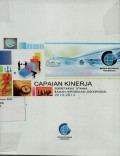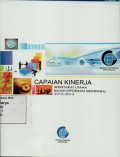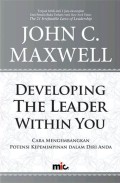
Flight
The world of manned flight from its primitive beginnings through the sophisticated present to the science-fiction future makes up the scope of this book. It covers the history of flight, thr theor…
- Edisi
- -
- ISBN/ISSN
- -
- Deskripsi Fisik
- 200 hlm.
- Judul Seri
- -
- No. Panggil
- R 629.13 GUY l
Coastal challenges: a guide to coastal and marine issues
- Edisi
- -
- ISBN/ISSN
- -
- Deskripsi Fisik
- iv, 178 hlm. : illus.
- Judul Seri
- -
- No. Panggil
- 333.9164 Env C
- Edisi
- -
- ISBN/ISSN
- -
- Deskripsi Fisik
- iv, 178 hlm. : illus.
- Judul Seri
- -
- No. Panggil
- 333.9164 Env C
Beleids commissie remote sensing, Netherlands remote sensing board
- Edisi
- -
- ISBN/ISSN
- -
- Deskripsi Fisik
- 148 hlm. : illus.
- Judul Seri
- -
- No. Panggil
- 621.3678 JAA b
- Edisi
- -
- ISBN/ISSN
- -
- Deskripsi Fisik
- 148 hlm. : illus.
- Judul Seri
- -
- No. Panggil
- 621.3678 JAA b
informasi sumberdaya laut dan pesisir Biak propinsi Irian Jaya
Maksud dan tujuan dar kegiatan ini adalah untuk menyusun data dasar yang berupa data grafis peta dasar yang berupa data grafis peta dasar (peta LPI) dan peta-peta tematik mengenai informasi potensi…
- Edisi
- -
- ISBN/ISSN
- -
- Deskripsi Fisik
- 80 hlm.
- Judul Seri
- -
- No. Panggil
- 333.9164 SUK i
Pemetaan neraca dan valuasi ekonomi mangrove Jawa
Maksud dari kegiatan ini adalah untuk mengetahui perubahan luas, kondisi eksisting hutan mangrove, serta nilai ekonomi dari pemanfaatan mangrove di sebagian wilayah pesisir Pulau Jawa secara spasia…
- Edisi
- -
- ISBN/ISSN
- 978-979-1266-90-1
- Deskripsi Fisik
- viii, 127 hlm.
- Judul Seri
- -
- No. Panggil
- 333.75 DOD p
Potensi budidaya pesisir di kota Bitung
Salah satu cara dalam meningkatkan produksi budidaya pesisir adalah dengan melakukan ekstensifikasi atau perluasan lahan. Tujuan penyusunan buku ini adalah menjelaskan penentuan wilayah yang berpot…
- Edisi
- -
- ISBN/ISSN
- 978-979-1266-89-5
- Deskripsi Fisik
- vi, 73 hlm. : illus.
- Judul Seri
- -
- No. Panggil
- 333.9164 TRI p

Capaian kinerja Sekretariat Utama Badan Informasi Geospasialo 2010-2014
Capaian kinerja Sekretariat Utama Badan Informasi Geospasial periode 2010-2014 disajikan sebagai laporan Sekretaris Utama dan jajarannya kepada pimipinan dan seluruh kaaryawan BIG dengan memberikan…
- Edisi
- -
- ISBN/ISSN
- -
- Deskripsi Fisik
- xiv, 98 hlm. : illus. ; 20 cm.
- Judul Seri
- -
- No. Panggil
- 658.306 BUD c

Capaian kinerja Sekretariat Utama Badan Informasi Geospasial 2010-2014
Capaian Kinerja Sekretariat Utama Badan Informasi Geospasial periode 2010-2014 disajikan sebagai laporan Sekretariat Utama dan jjajarannya kepada Pimpinan dan seluruh Karyawan BIG dengan memberikan…
- Edisi
- -
- ISBN/ISSN
- -
- Deskripsi Fisik
- xiv, 98 hlm. : illus. ; 20,5 cm.
- Judul Seri
- -
- No. Panggil
- Buku.Karya 2019/ 330.1 BUD c
Informasi geospasial mangrove Indonesia
Buku peta mangrove nasional ini sebagai sarana untuk melihat konfigurasi area mangrove di Indonesia. Informasi geospasial mangrove dalam kegiatan ini dilakukan dengan menggunakan metode interpretas…
- Edisi
- -
- ISBN/ISSN
- 978-979-1266-93-3
- Deskripsi Fisik
- ix, 335 hlm. : illus.
- Judul Seri
- -
- No. Panggil
- 333.75 GUR i

Ekspedisi geografi Indonesia Bali 2007
Ekspedisi Geografi Indonesia (EGI) 2007 merupakan salah satu program Bakosurtanal yaitu melakukan inventarisasi sumber daya alam Indonesia. Salah satu keunikan fenomena geografi di Indonesia adalah…
- Edisi
- -
- ISBN/ISSN
- 978-979-9497-74-1
- Deskripsi Fisik
- 104 hlm. : illus.
- Judul Seri
- -
- No. Panggil
- Buku.Karya 2007/36 BAD e

Statistical Methods for Spatial Data Analysis: Texts in Statistical Science
- Edisi
- -
- ISBN/ISSN
- -
- Deskripsi Fisik
- 372 hlm. ilus.
- Judul Seri
- -
- No. Panggil
- 519.2 Mic P
- Edisi
- -
- ISBN/ISSN
- -
- Deskripsi Fisik
- 372 hlm. ilus.
- Judul Seri
- -
- No. Panggil
- 519.2 Mic P
Prepocessing and Analytical Results of the Tidal Gravity Observations Recorde…
- Edisi
- -
- ISBN/ISSN
- -
- Deskripsi Fisik
- 12 hlm. illus.
- Judul Seri
- -
- No. Panggil
- 526.1 CHE p
- Edisi
- -
- ISBN/ISSN
- -
- Deskripsi Fisik
- 12 hlm. illus.
- Judul Seri
- -
- No. Panggil
- 526.1 CHE p

Cara perhitungan pasang laut dengan metode admiraty
- Edisi
- -
- ISBN/ISSN
- -
- Deskripsi Fisik
- 42 hlm. ilus.
- Judul Seri
- -
- No. Panggil
- 526.6 Roc C
- Edisi
- -
- ISBN/ISSN
- -
- Deskripsi Fisik
- 42 hlm. ilus.
- Judul Seri
- -
- No. Panggil
- 526.6 Roc C

Developing the leader within you: cara mengembangkan potensi kepemimpinan dal…
Testimonials like bobs have encouraged me to devote much of my time to developing leaders. it is the reason why i hold leadership seminars in the united states and other countries about ten times a…
- Edisi
- -
- ISBN/ISSN
- 9780785281122
- Deskripsi Fisik
- xii, 208 hlm, 21,5 cm
- Judul Seri
- -
- No. Panggil
- 658.4092 JOH d
Panduan untuk menjadi MC profesional
Profesi Master of Ceremony atau Pembawa Acawa (MC/PA) sudah mendapat pengakuan dan memperoleh penghargaan yang baik dalam masyarakat dan berkembang menjadi suatu profesi yang profitable. Deang sema…
- Edisi
- -
- ISBN/ISSN
- 978-979-22-0856-6
- Deskripsi Fisik
- xi, 145 hlm. illus.
- Judul Seri
- -
- No. Panggil
- 372.622 LIE p

Kebijakan inventarisasi dan evaluasi sumberdaya alam dan lingkungan hidup
- Edisi
- -
- ISBN/ISSN
- -
- Deskripsi Fisik
- 146 hlm.
- Judul Seri
- -
- No. Panggil
- 333.7 Ari K
- Edisi
- -
- ISBN/ISSN
- -
- Deskripsi Fisik
- 146 hlm.
- Judul Seri
- -
- No. Panggil
- 333.7 Ari K
Laporan survei hidrografi di wilayah Lampung
- Edisi
- -
- ISBN/ISSN
- -
- Deskripsi Fisik
- vii, [534] hlm. : illus.
- Judul Seri
- -
- No. Panggil
- 526.99 Tri L
- Edisi
- -
- ISBN/ISSN
- -
- Deskripsi Fisik
- vii, [534] hlm. : illus.
- Judul Seri
- -
- No. Panggil
- 526.99 Tri L
Prosiding forum riset geomatika (GeoReForm) 2007: Peran kajian geospasial da…
Tujuan kegiatan ini adalah untuk menentukan wilayah resiko bermacam bahaya lingkungan khusunya banjir, kebakaran dan penyakit DBD di 3 Kelurahan serta menentukan jumlah penduduk yang tercakup yang …
- Edisi
- -
- ISBN/ISSN
- -
- Deskripsi Fisik
- -
- Judul Seri
- -
- No. Panggil
- Buku.Karya 2007/12.III AMI p
Laporan akhir pengembangan basis data untuk website tahap II
- Edisi
- -
- ISBN/ISSN
- -
- Deskripsi Fisik
- iv, iii hlm. illus.
- Judul Seri
- -
- No. Panggil
- 005.74 Cac L
- Edisi
- -
- ISBN/ISSN
- -
- Deskripsi Fisik
- iv, iii hlm. illus.
- Judul Seri
- -
- No. Panggil
- 005.74 Cac L
Neraca dan valuasi ekonomi sumberdaya hutan mangrove
- Edisi
- -
- ISBN/ISSN
- 979-3149-64-7
- Deskripsi Fisik
- 78 hlm.
- Judul Seri
- -
- No. Panggil
- 583.763 Irm N
- Edisi
- -
- ISBN/ISSN
- 979-3149-64-7
- Deskripsi Fisik
- 78 hlm.
- Judul Seri
- -
- No. Panggil
- 583.763 Irm N
 Batas Wilayah
Batas Wilayah  Ekologi
Ekologi  Fotogrametri
Fotogrametri  Geografi
Geografi  Geologi
Geologi  GIS
GIS  Ilmu Tanah
Ilmu Tanah  Kartografi
Kartografi  Manajemen Bencana
Manajemen Bencana  Oceanografi
Oceanografi  Penginderaan Jauh
Penginderaan Jauh  Peta
Peta